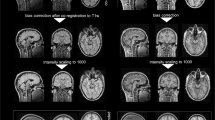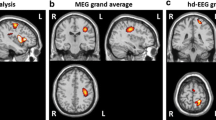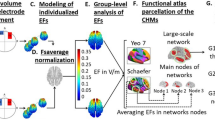Abstract
The purpose of this study is to evaluate the difference between anatomical locations of mismatch negativity (MMN) generators using a realistic head model and the Talairach coordinate system. This was performed by dipole source analysis by using a high density 128 channel electroencephalography (EEG) acquisition system and the subjects' individual 3D magnetic resonance images (MRI) for the realistic head model, in 24 healthy subjects. For dipole source localization, both the Talairach coordinate system and the individual MRI realistic head models were used and location results were compared. The MMN generators were clearly localized in the superior temporal gyri, especially in Heschl's gyrus, according to each individual's structural MRI. Only 37.5% of subjects showed the same anatomical locations of the MMN generator in both hemispheres in the realistic head model and in Talairach coordinate system, but fifteen subjects (62.5%) didn't. This result indicates that individually registered functional locations are desirable for the precise localization of activated areas in functional imaging studies and that a brain coordinate system is needed which adequately accounts for ethnic differences.
Similar content being viewed by others
References
Ackermann, H., Lutzenberger, W. and Hertrich, I. Hemispheric lateralization of the neural encoding of temporal speech features: a whole-head magnetencephalography study. Brain Res. Cogn. Brain Res., 1999, 7: 511-518.
Alho, K., Connolly, J.F., Cheour, M., Lehtokoski, A., Huotilainen, M., Virtanen, J., Aulanko, R. and Ilmoniemi, R.J. Hemispheric lateralization in preattentive processing of speech sounds. Neurosci. Lett., 1998a, 258: 9-12.
Alho, K., Winkler, I., Escera, C., Huotilainen, M., Virtanen, J., Jaaskelainen, I.P., Pekkonen, E. and Ilmoniemi, R.J. Processing of novel sounds and frequency changes in the human auditory cortex: magnetoencephalographic recordings. Psychophysiology, 1998b, 35: 211-224.
Boon, P., D'Have, M., Vanrumste, B., Van Hoey, G., Vonck, K., Van Walleghem, P., Caemaert, J., Achten, E. and De Reuck, J. Ictal source localization in presurgical patients with refractory epilepsy. J. Clin. Neurophysiol., 2002, 19: 461-468.
Buchner, H., Waberski, T.D., Fuchs, M., Wischmann, H.A., Wagner, M. and Drenckhahn, R. Comparison of realistically shaped boundary-element and spherical head models in source localization of early somatosensory evoked potentials. Brain Topogr., 1995, 8: 137-143.
Cuffin, B.N. EEG dipole source localization. IEEE Eng. Med. Biol. Mag., 1998, 117: 118-122.
Deouell, L.Y., Bentin, S. and Giard, M.H. Mismatch negativity in dichotic listening: evidence for interhemispheric differences and multiple generators. Psychophysiology, 1998, 35: 355-365.
Fox, P.T. Spatial normalization: origins, objectives, applications and alternatives. Hum.Brain Mapp., 1995, 3: 161-164.
Fuchs, M., Drenckhahn, R., Wischmann, H.A. and Wagner, M. An improved boundary element method for realistic volume-conductor modeling. IEEE Trans. Biomed. Eng., 1998, 45: 980-997.
Gevins, A. The future of electroencephalography in assessing neurocognitive functioning. Electroencephalogr. Clin. Neurophysiol., 1998, 106: 165-172.
Giard, M.H., Perrin, F., Pernier, J. and Bouchet, P. Brain generators implicated in the processing of auditory stimulus deviance: a topographic event-related potential study. Psychophysiology, 1990, 27: 627-640.
Han, S., Fan, S., Chen, L. and Zhuo, Y. Modulation of brain activities by hierarchical processing: a high-density ERP study. Brain Topogr., 1999, 11: 171-183.
Hari, R., Hamalainen, M., Ilmoniemi, R., Kaukoranta, E., Reinikainen, K., Salminen, J., Alho, K., Näätänen, R. and Sams, M. Responses of the primary auditory cortex to pitch changes in a sequence of tone pips: neuromagnetic recordings in man. Neurosci. Lett., 1984, 50: 127-132.
Jemel, B., Achenbach, C., Muller, B.W., Ropcke, B. and Oades, R.D. Mismatch negativity results from bilateral asymmetric dipole sources in the frontal and temporal lobes. Brain Topogr., 2002, 15: 13-27.
Kaiser, J. and Lutzenberger, W. Location changes enhance hemispheric asymmetry of magnetic fields evoked by lateralized sounds in humans. Neurosci. Lett., 2001, 314: 17-20.
Kasai, K., Nakagome, K., Itoh, K., Koshida, I., Hata, A., Iwanami, A., Fukuda, M., Hiramatsu, K.I. and Kato, N. Multiple generators in the auditory automatic discrimination process in humans. Neuroreport, 1999, 10: 2267-2271.
Kreitschmann-Andermahr, I., Rosburg, T., Meier, T., Volz, H.P., Nowak, H. and Sauer, H. Impaired sensory processing in male patients with schizophrenia: a magnetoencephalographic study of auditory mismatch detection. Schizophr Res, 1999, 35: 121-129.
Laarne, P.H., Tenhunen-Eskelinen, M.L., Hyttinen, J.K. and Eskola, H.J. Effect ofEEGelectrode density on dipole localization accuracy using two realistically shaped skull resistivity models. Brain Topogr., 2000, 12: 249-254.
Lancaster, J.L., Rainey, L., Summerlin, J.L., Freitas, C.S., Fox, P.T., Evans, A.E., Toga, A.W. and Mazziotta, J.C. Automated labeling of the human brain: A preliminary report on the development and evaluation of a forward-transform method.Hum. Brain Mapp., 1997, 5: 238-242.
Lancaster, J.L., Woldorff, M.G., Parsons, L.M., Liotti, M., Freitas, C.S., Rainey, L., Kochunov, P.V., Nickerson, D., Mikiten, S.A. and Fox, P.T. Automated Talairach atlas labels for functional brain mapping. Hum. Brain Mapp., 2000, 10: 120-131.
Näätänen, R. Mismatch negativity (MMN): perspectives for application. Int. J. Psychophysiol., 2000, 37: 3-10.
Näätänen, R., Gaillard, A.W. and Mantysalo, S. Early selective-attention effect on evoked potential reinterpreted. Acta. Psychol. (Amst.), 1978, 42: 313-329.
Näätänen, R., and Michie, P.T. Early selective-attention effects on the evoked potential: a critical review and reinterpretation. Biol. Psychol., 1979, 8: 81-136.
Park, H.J., Kwon, J.S., Youn, T., Pae, J.S., Kim, J.J., Kim, M.S. and Ha, K.S. Statistical parametric mapping of LORETA using high density EEG and individual MRI: application to mismatch negativities in schizophrenia. Hum. Brain Mapp., 2002, 17: 168-178.
Rinne, T., Alho, K., Ilmoniemi, R.J., Virtanen, J. and Näätänen, R. Separate time behaviors of the temporal and frontal mismatch negativity sources. Neuroimage, 2000, 12: 14-19.
Scherg, M., Picton, T.W. and Vajsar, J. A source analysis of the human auditory evoked potentials. J. Cogn. Neurosci., 1989, 1: 336-355.
Scherg, M. and Von Cramon, D.Two bilateral sources of the late AEP as identified by a spatio-temporal dipole model. Electroencephalogr. Clin. Neurophysiol., 1985, 62: 32-44.
Talairach, J. and Tournoux, P. Co-Planar Stereotaxic Atlas of the Human Brain. Verlag; Stuttgart: Thieme, 1988.
Waberski, T.D., Buchner, H., Lehnertz, K., Hufnagel, A., Fuchs, M., Beckmann, R. and Rienacker, A. Properties of advanced head modelling and source reconstruction for the localization of epileptiform activity. Brain Topogr., 1998, 10: 283-290.
Waberski, T.D., Kreitschmann-Andermahr, I., Kawohl, W., Darvas, F., Ryang, Y., Gobbele, R. and Buchner, H. Spatio-temporal source imaging reveals subcomponents of the human auditory mismatch negativity in the cingulum and right inferior temporal gyrus. Neurosci. Lett., 2001, 308: 107-110.
Youn, T., Park, H.J., Kim, J.J., Kim, M.S. and Kwon, J.S. Altered hemispheric asymmetry and positive symptoms in schizophrenia: equivalent current dipole of auditory mismatch negativity. Schizophr. Res., 2003, 59: 253-260.
Zilles, K., Kawashima, R., Dabringhaus, A., Fukuda, H. and Schormann, T. Hemispheric shape of European and Japanese brains: 3-D MRI analysis of intersubject variability, ethnical, and gender differences. Neuroimage, 2001, 13: 262-271.
Author information
Authors and Affiliations
Rights and permissions
About this article
Cite this article
Ha, K.S., Youn, T., Kong, S.W. et al. Optimized Individual Mismatch Negativity Source Localization Using a Realistic Head Model and the Talairach Coordinate System. Brain Topogr 15, 233–238 (2003). https://doi.org/10.1023/A:1023910108759
Issue Date:
DOI: https://doi.org/10.1023/A:1023910108759




